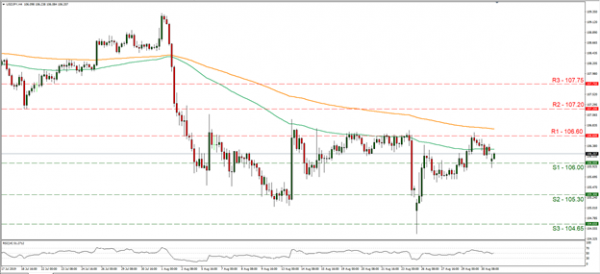JPY strengthened somewhat during today’s Asian session, as the US tariffs on imports from China kicked in on Sunday. The US tariffs apply on roughly 110 billion US dollars’ worth of imports from China at 15%, hitting consumer goods from textiles to certain technology products. A second wave is to hit the markets on December 15th and is expected to affect even more consumer goods. The US President tweeted that his aim was to reduce US reliance on China and again urged US companies to find alternate suppliers outside China. It should be noted that the Chinese responded in kind, mirroring US tariffs by levying some on Sunday while delaying others for the 15th of December. According to analysts it’s also noteworthy that the Chinese for the first-time targeted US crude oil with a 5% tariff. We could see safe havens strengthen on the recent escalation, despite the fact being widely expected, while on the other hand emerging markets could weaken further. We await the European and US opening for more clues, however as negotiations are on the way, there could be further developments. Please bear in mind that the US market (& Canada) are closed for Labour Day today. USD/JPY opened with a negative gap during today’s Asian opening, yet corrected somewhat, as the 106.00 (S1) support line held. Due to the recent developments in the US -Sino relationships and the downward movement in the past two days, we tend to maintain some bearish expectations for the pair. Should the pair come under the selling interest of the market, we could see it breaking the 106.00 (S1) support line and aim for lower grounds. Should the pair’s long positions be favoured by the market, we could see it aiming if not breaking the 106.60 (R1) resistance line.
RBA Interest rate decision
Tomorrow during the late Asian session (04:30,GMT) , we get RBA’s interest rate decision. The bank is widely expected to remain on hold at +1.00% and currently AUD OIS imply a probability of 88.23% for such a scenario. Given that the CPI rate remains below the bank’s target range of +2.00%-3.00% yoy and the recent escalation in the US-Sino trade war, we could see the bank maintaining a dovish tone. Also please bear in mind that the market seems to have priced in another rate cut by the end of the year according to AUDOIS. Should the bank outweigh the market’s dovish expectations we could see the Aussie weakening further. AUD/USD also opened with a negative gap during today’s Asian session remaining below the 0.6740 (R1) resistance line. For our bearish outlook for the pair, to change, we would require it to clearly break the downward trendline incepted since the 26th of August. Should the bears maintain control over the pair’s direction, we could see it aiming if not breaking the 0.6675 (S1) support line. Should the bulls take over, we could see it breaking the 0.6740 (R1) resistance line and aim for higher grounds.
Other economic highlights today and early tomorrow
Today during the European session we get Germany’s final manufacturing PMI for August as well as UK’s manufacturing PMI for August. During tomorrow’s Asian session and ahead of RBA’s interest rate decision, we get Australia’s retail sales growth rate for July.
As for the week ahead
On Tuesday, we UK’s construction PMI for August, and the ISM Mfg PMI also for August. On Wednesday, we get Australia’s GDP for Q2, UK’s services PMI for August, Eurozone retail sales for July and from Canada BoC’s interest rate decision. On Thursday, Australia’s trade balance for July and from the US the ISM Non-Mfg PMI for August. On Friday, we get Eurozone’s GDP for Q2, the US employment report for August, Canada’s employment data Ivey PMI, both for August.
Support: .0.6675 (S1), 0.6610 (S2), 0.6540 (S3)
Resistance: 0.6740 (R1), 0.6800 (R2), 0.6860 (R3)
Support: 106.00 (S1), 105.30 (S2), 104.65 (S3)
Resistance: 106.60 (R1), 107.20 (R2), 107.75 (R3)

















